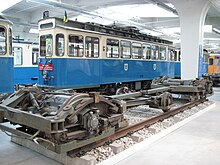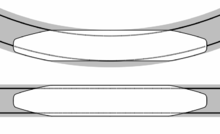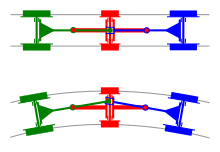Steering three-axle

Lenkdreiachser are triaxial trams with a particular disk drive design , in which the driving axles by an intermediate carrying axle in the bows radially be adjusted. Steering three-axle vehicles were essentially built between the 1930s and 1960s and were in use until the turn of the millennium. In some cases, they were also classified as open- plan coaches, although this term mostly refers to four-axle coaches.
Construction principle
In contrast to steering axles , which automatically adjust radially in the curve, the axles are forcibly guided in the three-axle steering.
The three-axle steering chassis consists of two single-axle bogies rotatably mounted in the frame , between which a laterally movable running axle is arranged. This only has the function of adjusting the outer axes in the track curve radially using kinematics . Since the running axle only has to be loaded so heavily that it stays safely on the track, up to 90 percent of the railcar mass is used for traction (for example, with the Munich M railcar 130 kN - 30 kN - 130 kN axle load = 87 percent). The wheel arrangement is therefore A'1'A 'for the railcars and 1'1'1' for the side cars.

When most widespread West wagon -Lenkgestell is this kinematics on the one hand shafts to the single-axle bogies that are hinged together in the middle so the two bogies that always at the same angle to the car body to adjust. The running axle has drawbars on both sides that engage in the middle of the driving axle drawbars. Thus, the running axis is inevitably guided exactly on the bisector of the outer axes along the center of the carriage. All three axes are set exactly radially.

Steering three-axle vehicles had advantages over other contemporary designs:
- Compared to two-axle vehicles, but also to bogie vehicles, they were able to drive through tight bends with less wear, because the wheel sets running exactly radially did not cause the flanges to run into the running edges of the rail heads. In Munich, with its tight arches (at that time a twelve-meter radius), that was decisive for the choice of the three-axle steering wheel.
- Because of the larger wheelbase, a longer car body was possible compared to two-axle vehicles, in principle identical to a four-axle open-plan car. In fact, however, the three-axle steering vehicles built were shorter than four-axle vehicles in order not to let the axle load become too great.
- Compared to maximum railcars , the adhesion (proportion of the vehicle mass used for propulsion) is significantly better (around 85 versus around 65 percent), and not significantly worse compared to vehicles with all-axle drives.
- Compared to four-axle vehicles with all-axle drive by means of paw-bearing motors , two motors were saved, compared to maximum railcars one running axle and the bogies.
But they also have serious disadvantages:
- The axle load is high (compared to four-axle vehicles of comparable capacity) (for example 130 kN for Munich M-railcars versus 100 kN for P-railcars). This leads to increased wear and tear and structure-borne noise emissions.
- The wheel sets are set exactly radially in the arch, but larger inclinations occur at the arch entry and in counter arches.
- The running properties are similar to two-axle vehicles and are accordingly poor. In particular, shocks are not halved as with bogie cars.
- The adaptation of the relatively rigid running gear to the track position is significantly worse than with bogie vehicles. That is why the M-trains delivered to the Bucharest tram were converted into bogie cars there.
history
In 1889, the US company "Robinson Radial Truck" constructed the first three-axle steering truck, which ran in Boston, St. Louis, Washington DC and New Jersey, among others. The Hamburg tram bought such a chassis in 1896 and equipped their car 600 with it. In 1902 MAN supplied three railcars with a three-axle steering frame designed by them for the Bergische Kleinbahnen in Wuppertal.
In 1929 the Vienna tram received two type P test cars , in which the engines (unlike most other designs with dead-end bearing engines ) were on the central axis and connected to the drive axles by means of cardan shafts. Otherwise they largely corresponded to the then current two-axle type M 1 . There was no series production (among other things because the steering frame was very maintenance-intensive), and in 1949 the P were converted back to ordinary two-axle vehicles.
In 1932 the Westfälische Straßenbahn tested a test car with Bäseler steering axles, in which steering arms arranged outside the center of the car were responsible for the deflection instead of the drawbars. In the 1930s, the Schweizerische Lokomotiv- und Maschinenfabrik designed its Buchli steering frame, which Saarbrücken fitted seven vehicles with in 1933 and 1936. In 1939, the Zurich tram received two Buchli steering three-axle vehicles of the type Ce 2/3, which are considered the forerunners of the Swiss standard car .
From the Buchli steering frame, Westwaggon developed the Westwaggon steering frame named after the company, which, however, was only procured in Germany or reproduced under license. Before the Second World War, Gera, Bremen and Cologne put smaller numbers of this type into service. In the course of the development of the German standard tram , a three-axle variant was designed, but the order for two prototypes by Berlin in 1942 could no longer be carried out due to the war. In Leipzig in 1942, eleven Maximum railcars were converted to western wagon steering racks.
After the war, smaller series of only a few copies each were built for Dortmund, Duisburg, Herne-Castrop-Rauxel, Lübeck, Remscheid, Rheydt, Neuss, Mainz, Bonn and Wuppertal. In the GDR , too , LOWA constructed a three-axle sidecar as the BEL 50 type , the only example of which was used on the Schmöckwitz-Grünauer Uferbahn in Berlin.
There were larger numbers of steering three-axle vehicles in Munich, Augsburg, Oberhausen, Amsterdam and Basel ( see below ). Even when these trains were being built, other designs such as the Duewag open-plan coaches were much more successful. In 1968, for example, the Augsburg GT5 was the last car with a three-axle steering rack.
Companies with steering three-axle vehicles
Amsterdam
In 1949, Amsterdam purchased a three-axle series of 60 powered rail vehicles and 50 sidecars from Werkspoor . They were in use until 1983. The railcar 902 and the sidecar 968 have been in the holdings of the Hanover Tramway Museum since 2011 .
augsburg

In 1956, Augsburg had eleven railcars with sidecars supplied by MAN for its meter-gauge operation , the car bodies of which largely corresponded to the Munich M-cars.
The next series were delivered in 1964 and 1968 as five-axle articulated railcars GT5 , in which a steering three -axle vehicle formed the front part, on which a trailer with a two-axle bogie was saddled. These were the last three-axle steering vehicles built worldwide. In 1968/69 the existing three-axle vehicles were also rebuilt in the same way, so that in the end there were 42 five-axle vehicles. The last cars were decommissioned in 2000.
Basel
The Basler transporting enterprises (BVB) received in 1933 (20 cars with the numbers 703 to 722) and 1943 (ten wagons No 723-732) together 30 three-axle trailer car by the manufacturers SIG and SWS. The decisive factor for the order was the positive experience with the test car 702 delivered in 1931, which was subsequently given a three-axle undercarriage in 1933. BVB manufactured a further twelve three-axle trailers in its own workshop between 1956 and 1964, and SLM supplied the chassis. They were given the numbers 1333–1344 and some of them still run on the Belgrade tram in Serbia today . In 1954/55, BVB also converted the 1301 loner sidecar, which had been purchased in 1930, into a three-axle vehicle, so that there were 43 three-axle trailers on the Basel tram .
Bonn
From 1950 to 1955, Bonn received 20 motor coaches and eleven sidecars specially for the route to Mehlem . They were two-judges and with five windows on each side of the car they were significantly longer and wider than other German three-axle vehicles. They also received rounded car fronts, which were very modern at the time.
Ghent
The Ghent tram also had three-axle steering wheels.
Leipzig
In 1909, Leipziger Außenbahn AG purchased twenty railcars with maximum bogies. As the only type owned by this subsidiary of the Great Leipzig Tram, they received numbers 1 to 20 and the type designation 24. In 1930 they were included in the urban designation system with the numbers 1378 to 1397. Between 1941 and 1943, eleven cars were converted to steering three-axle bogies from Westwaggon Cologne, the prototype 1387 was created as early as 1939. The type designation changed to 24a, the external appearance after the conversion roughly corresponded to the Pullman car type 22 after the conversion to target film equipment, but they had the only one in Leipzig with five compartments and no lengthways seats. The eleven steering three-axle vehicles remained in the passenger car fleet until the mid-1970s. In the last few years of operation, they were used as staff cars in the main workshop and as emergency vehicles. Car 1378, previously LAAG 1, was retained; after 2000 it was refurbished to become an operational museum car in the state it was in after the renovation in 1943.
Luxembourg
In 1938, the Luxembourg tram converted its number 26 railcar from the 1920s as the only one in its series to be a three-axle vehicle. At the same time, the three sidecars 120–122, which had three axles ex works, were procured.
Munich

The Munich-based M Series is a total of 286 motor coaches and 246 sidecar of most built tram Dreiachser the world. The prototypes of the M1 type were largely derived from the Berlin standard car project, which was canceled due to the war. The vehicles were delivered by the Rathgeber company between 1950 and 1965 and were in regular service until 1997. Several trains are still preserved, one of which is operational.
The two articulated train prototypes of the P1.65 series represented a special feature, in which two three-axle vehicles were connected by a floating middle section .
Oberhausen
From 1949 to 1957, Oberhausen put a total of 23 railcars with the numbers 301 to 323 into service. The car bodies corresponded to the body type . The cars became the standard type in Oberhausen and were in use in Mülheim an der Ruhr until 1978 after the Oberhausen tram was shut down . Car 322 is preserved there as a museum car.
Zurich – Esslingen
Apart from the Zurich tram, the Forchbahn from Zurich also had a steering three-axle vehicle with the BDe 2/3 number 6. It was procured in 1915 and remained a unique piece.
literature
- Martin Pabst, paperback German streetcar railcars. Electric railcars 1881-1931 , Frankh'sche Verlagshandlung Stuttgart 1981, ISBN 3-440-04941-8
- Martin Pabst, paperback German streetcar railcars. Electric railcars 1931-today , Frankh'sche Verlagshandlung Stuttgart 1982, ISBN 3-440-05043-2
- Lutz Uebel and Wolfgang-D. Richter (Ed.): 150 years of rail vehicles from Nuremberg , EK-Verlag Freiburg 1994, ISBN 3-88255-562-9 , page 455ff
- Martin Pabst, The Munich Tram ; GeraMond Munich 2000, ISBN 3-932785-05-3
- Hans Bodmer, half a thing on 3 axes . In: Straßenbahn Magazin August 2019, ISSN 0340-7071, pages 52 to 58 (about the Zurich carriages 31 and 32 and the early development of the three-axle steering wheel).
Web links
- M-Wagen on www.strassenbahn-muenchen.de
Individual evidence
- ↑ L-railcar on www.strassenbahn-muenchen.de
- ↑ The series 511 to 521 at www.fdas.de ( Memento of the original from October 29, 2013 in the Internet Archive ) Info: The archive link was inserted automatically and has not yet been checked. Please check the original and archive link according to the instructions and then remove this notice.
- ↑ a b Local transport in Munich , tram special No. 2, GeraNova Munich without year (circa 1997), ISSN 0340-7071 , page 49
- ↑ Illustration of the Robinson Radial Truck on the webpage of the Shore Line Trolley Museum
- ↑ Paperback 1881–1931 (see literature), pages 170/171
- ^ Type P (Vienna, 1929-1971). Article in Stadtverkehr-Austria-Wiki, accessed on September 30, 2014.
- ↑ Paperback 1932-heute (see literature), pages 68/69
- ↑ Hans Bodmer, Half a thing on 3 axes . In: Tram Magazine August 2019, ISSN 0340-7071, pages 52 to 58
- ↑ Taschenbuch 1932-heute (see literature), pages 71–82.
- ↑ See vehicle list on the HSM website
- ↑ Lutz Uebel and Wolfgang-D. Richter (Ed.): 150 years of rail vehicles from Nuremberg , EK-Verlag Freiburg 1994, ISBN 3-88255-562-9 , page 455ff
- ↑ Description of the Basel trailer B3 1303–1332 on www.g-st.ch
- ↑ Description of the Basel trailer B3 1333–1344 on www.g-st.ch
- ^ Description of the Basel trailer B3 1301 on www.g-st.ch
- ↑ Axel Reuther, Album of the German Tram and Light Rail Vehicles 1948–2005, Munich, GeraMond, 2007, p. 23.
- ↑ Paperback 1932-heute (see literature), page 76
- ↑ Photos of the car 322 on www.trampicturebook.de






